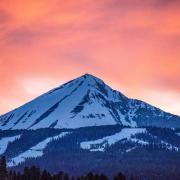Big Sky Wildlife Spotlight: Wolverines
Wolverines are powerful, fierce creatures that live in remote and rugged mountain terrain. These legendary and solitary animals are relatively elusive, but they definitely exist in the mountains of Big Sky Country.
After wolverines almost went extinct in Montana in the 1900’s, the Treasure State is now home to the largest population of wolverines in the Lower 48. Wolverines, which are the largest terrestrial member of the weasel family, thrive in the vast tracks of wilderness, forest service lands, and National Parks of this region.
Wolverines avoid human contact whenever possible, but a keen eye can spot their distinct tracks in the snow during the winter. If you’re lucky enough to see one, give it plenty of space because wolverines have a dangerous reputation.

Let's take a look at some interesting facts about wolverines:
- The wolverine’s scientific name is Gulo gulf, which means “glutton” in Latin.
- They are sometimes called devil bear, skunk bear, carcajou, quick hatch, or devil beast.
- The primary habitat for wolverines is alpine tundra and mountain forests in upper latitudes of the northern hemisphere.
- These bear-like mustelids are strong limbed with dark brown fur and yellowish stripes extending from their shoulders to their rumps.
- Each wolverine’s color patterns are unique - like a thumbprint.
- Wolverines weight between 25 and 60 pounds.
- They stretch 30 to 50 inches long including a 7 to 10 inch tail.
- A wolverine’s feet are 6 to 11 cm long and have sharp, non-retractable claws.
- Their feet spread to twice their normal size to act like snowshoes during the winter.
- Wolverines do NOT hibernate.
- They den in caves, rock crevices, or under fallen trees.
- They are opportunistic feeders that will eat just about anything that’s dead or alive. They are scavengers and predators that will eat roots, berries, and small mammals, but they will also attack moose, caribou and deer.
- Wolverines have a keen sense of smell that can detect a dead animal 20 feet under the snow.
- Wolverines will dig into burrows and kill hibernating animals.
- Their strong jaws can crush and eat large bones.
- Wolverines will refrigerate their kills in the snow.
- Wolverines will drive off packs of wolves and grizzly bears to protect their food.
- Their strength is out of proportion to their size.
- Wolverines can travel 30 to 40 miles per day.
- Wolverines suffer from poor eyesight and are primarily active at night.
- A wolverine’s home range can stretch several hundred square kilometers. On average a wolverine’s range in Montana is 422 square kilometers. Ranges do overlap.
- Wolverines are polygamous breeders who breed from April to October via delayed implantation. Gestation lasts 7 to 9 months and then females give birth to 1 to 6 young.
- Wolverine babies are called kits. Kits are born with white fur and are raised by the female, but the male will check in occasionally.
- The wolverine is not a protected species.
- Check with the Montana Fish, Wildlife, & Parks to get the latest information on trapping wolverines during fur harvest season in Montana.
- Some Alaskans are trying to train wolverines for Search and Rescue (OutsideOnline.com).
- In one Innu myth, the wolverine is the creator of the world.
If you capture a cool wildlife photo of a wolverine, be sure to share it on social media with #visitbigsky.
To learn more about Wolverines, read The Wolverine Way by Douglas Chadwick.
See Also:
- Big Sky Wildlife Spotlight: Wolves
- Big Sky Wildlife Spotlight: Grizzly Bears
- Big Sky Wildlife Spotlight: Bison
- Big Sky Wildlife Spotlight: Black Bears
- Big Sky Wildlife Spotlight: Rainbow Trout
- Big Sky Wildlife Spotlight: Coyote
- Big Sky Wildlife Spotlight: Mountain Lions
- Big Sky Wildlife Spotlight: Porcupines
- Big Sky Wildlife Spotlight: Great Horned Owl
- Big Sky Wildlife Spotlight: Mule Deer
- Big Sky Wildlife Spotlight: Pronghorns
Learn more interesting facts about wolverines from these sources:

